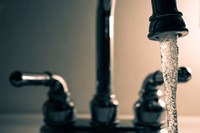
Introduction
Disasters are destructive events that inflict unexpected morbidity, mortality and shocks on socio-economic systems. While no one welcomes calamity, previous post-disaster assessments indicate that they may have at least some positive consequences for certain marginalized communities.[1] Immediate disaster intervention measures require massive financial and human resources. While in most cases these are intended to directly mitigate the disaster in question, there are not infrequently spillover benefits that may address societal challenges that otherwise might not have been prioritized.
For Water, Sanitation and Hygiene (WASH), the World Bank’s post-disaster needs assessment guidelines expressly postulate that disasters may create opportunities for systematic change. Furthermore, the recovery phase of service provision can also be an opportunity to seek more sustainable solutions. These may address chronic problems and gaps in the provision of, and access to WASH services in urban and rural populations.[2] This brief explores the extent to which the COVID-19 pandemic’s preventative interventions may have opened opportunities for the WASH sector.
Pre-existing WASH conditions
Provision of WASH infrastructure and services have been observed to be skewed across provinces and the rural/urban divide. With the emergence of the COVID-19 informal settlements and rural areas have been prioritized as highly vulnerable communities to the infection. The need for the implementation of COVID-19 WASH related preventative measures have most importantly revealed the depth of preexisting national WASH sector infrastructure investment backlog and inequalities. And most importantly this crisis has reminded the government of its constitutional obligations and duties.[3]
COVID-19 and the WASH sector
Following the elevation of the COVID-19 disaster to pandemic status, the World Health Organisation (WHO) made recommendations to help member states improve hand hygiene practices.[4]
The WHO recommendations and country-specific needs prompted initial funding of R306 million. The President has promised an additional R20-billion allocation to fund emergency water and sanitation provision during the state of national disaster. The targeted beneficiaries are low-income and vulnerable communities across the country.
Right now, this support has enabled the delivery of nearly 17 000 water storage tanks, over 1 200 water tankers, soaps and alcohol-based hand sanitizers as well as ablution facilities to these communities.
Envisaged Spillover for WASH
The interventions and disaster risk reduction measures are expected to offer potentially significant health and socio-economic benefits and opportunities for WASH in South Africa.
Health Opportunities: Providing proper WASH services may reduce the current water infrastructure backlog.
- This may aid in reducing non-COVID related infections associated with absence of WASH facilities and proper WASH practice (mainly faecal-oral infections). Investment in WASH facilities and practice interrupts transmission of waterborne diseases by reduced exposure to pathogens generally.
- Reduction in musculoskeletal disorders related to water-carrying, Geere et al[5] observed in a study conducted in Limpopo Province that participants with a history of current or past water-carrying more frequently reported pain in locations most likely to be associated with sustained spinal axial compression in the cervical region. This springs directly from load carriage on the head. Carrying water containers, particularly on the head (head loading), may impart physical stress to the bones and soft tissues of the neck and upper back. [6]
Socio-economic opportunities: Under-serviced communities and those obliged to fetch water sacrifice significant time walking to and from water points and queuing for water. Providing and sustaining water supply during and after disaster will free individuals and communities to seek and engage in income-generating activities. An additional consideration is that they are better enabled to care for their families and have more leisure time.[7]
Behavioural change: The World Bank[8] notes that the COVID-19 pandemic has made hand-washing facilities and promotion more urgent than ever. Across the world, people are heeding public health experts’ hand-washing advice with greater intensity. In South Africa, the COVID-19 emergency responses have effectively expanded national access to WASH facilities, services and awareness programmes and platforms. If the current improved state of hand hygiene can be maintained, this will assist in reducing the transmission of many hygiene-related infections.
But idle hopes are not enough. Practical planning is indispensable. To secure long-term benefit from COVID-infrastructural investment, a practical plan of action must be formulated and put in place. This should spell out in practical terms how beneficiary municipalities should maintain WASH infrastructure during and after disaster. Intended users should be able to continue benefiting from infrastructure enhancements beyond the epidemic. Aspects the plan should address include infrastructure maladministration and vandalism.
Omissions signal depth of WASH challenge
COVID-19 WASH interventions have received significant media attention and coverage. Yet, nearly three months after the national state of disaster was declared, for some vulnerable rural communities, realization of facilities remains elusive.
Information gleaned from the Ga-Kobe and Ga-Mphakani villages in Limpopo Province reveals stark continuing deficits in WASH provision (Appendix 1 and 2). Residents have not yet received WASH disaster relief facilities. Some still buy water from those with boreholes. Residents who cannot afford to pay are compelled to source their drinking water from unprotected and potentially hazardous sources (Appendix1).
Additionally, Leon Basson (on Politicsweb) revealed that residents of Moretele Village in the North West have not yet received emergency WASH infrastructure. Basson’s report also indicated that in Mbizana Eastern Cape the emergency tanks are empty since they were only filed upon delivery. [9] In a similar observation, Joseph Chirume (on GroundUp) reported that pandemic response emergency tanks in the Ramaphosa informal settlement in Motherwell, Port Elizabeth periodically run dry.[10] This raises the questions: How many vulnerable communities are still without disaster relief interventions? How many of those emergency tanks are empty? What sustained interventions are being planned and implemented to remedy this? This necessitates the further question whether the disaster task teams are even aware of these drastic shortfalls.
The present state not only reveals the depth and urgency of WASH sector challenges but invites consideration on the appropriate disaster relief approach. A salient question is whether a more decentralized approach would not be more practically productive. And planning should be more precisely needs-sensitive. Thus, Saban in 2014[11] indicated that effective disaster risk reduction requires community participation. Involving communities in design and implementation helps ensure that new infrastructure is well tailored to actual vulnerabilities and needs.
Implementation of disaster risk reduction measures, identifying vulnerable people, and sustaining the functionality of the emergency WASH infrastructure and services, require a mixed model. Top-down identification and implementation of disaster relief is methodologically and practically insufficient. It must be supplemented by and adjusted to feedback from beneficiaries. This could be realised in various ways. One would be to establish an online interactive tool to enable vulnerable communities to log shortcomings and failures, and to register complaints. This will not only help better establish the extent of the problem; it will give voice and visibility to those awaiting relief.
Concluding remarks
Disasters are obviously undesirable events; the calamity they entail too often wreaks destruction and generates actus uncertainties. However, for some communities there may be positive benefits, even if marginal. In South Africa, the COVID-19 disaster has underscored the most elementary human need – for water, sanitation and hygiene. This has entailed beneficial priority in WASH infrastructure capacitation for communities acutely vulnerable to infections. But, as with all benefits, three months’ passing of time reveals insufficient follow-through. Hence, for some rural communities, improvement remains elusive.
Nhlanhla Mnisi
nhlanhla@hsf.org.za
Appendix 1: Ga-Kobe Residents share water with Animals amid COVID-19
|
Community |
Ga-Kobe |
|
Province |
Limpopo |
|
Access to water |
· Water is sold by those who have boreholes. Residents who cannot afford water resort to unsafe sources e.g. pools and streams |
|
State of water quality |
· Unprotected sources shared with animals |
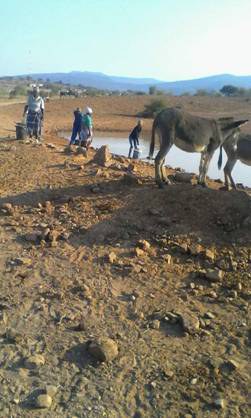
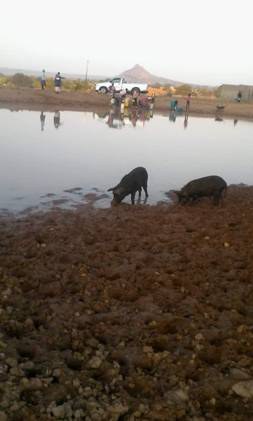
Appendix 2: Ga-Mphakani residents
|
Community |
Ga-Mphakani |
|
Province |
Limpopo |
|
Access to water |
· Residents have access to water points from 5:00 AM-9:00 AM and 4:00 PM to 6:00 PM (Monday to Saturday) and only 5:00 AM to 9:00 AM (Sundays). · They maintain their own water infrastructure. · The scheduling (I). rations access to water when it needed the most (II). It crowds people making social distancing impossible. |
|
State of water quality |
· Some of the residents complain that the borehole water is salty |
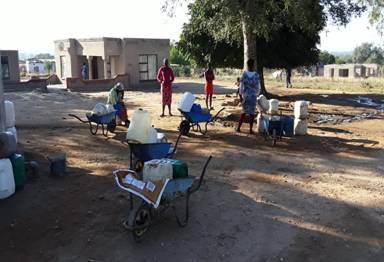
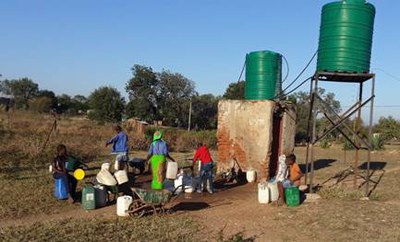
Residents queueing for water

Shared standpipes making social distance impossible
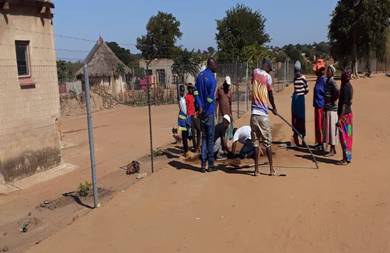
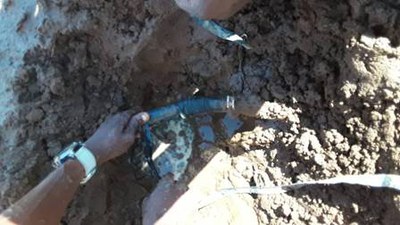
Residents fixing leaking water pipes
[1] https://jamba.org.za/index.php/jamba/article/view/99/231
[2] https://reliefweb.int/report/world/pdna-guidelines-volume-b-water-sanitation
[3] Chapter 2 of the Constitution: Everyone has the right to have access to sufficient food and water.
Water Services Act 108 of 1997: Provides for the right to basic water supply and basic sanitation services
[4] WHO 2020, URL: https://www.who.int/publications-detail/recommendations-to-member-states-to-improve-hand-hygiene-practices-to-help-prevent-the-transmission-of-the-covid-19-virus
[5] Geere et al 2018
[6] Jager et al1997
[7] Gomez et al., 2019.
[8] https://www.worldbank.org/en/news/feature/2020/04/30/covid-19-makes-handwashing-facilities-and-promotion-more-critical-than-ever
[9] https://www.politicsweb.co.za/politics/sisulus-covid19-water-scheme-ends-up-as-dry-run-ex?utm_source=Politicsweb+Daily+Headlines&utm_campaign=2ca8fa4491-EMAIL_CAMPAIGN_2020_05_21_12_15&utm_medium=email&utm_term=0_a86f25db99-2ca8fa4491-130030197
[10] https://www.groundup.org.za/article/water-tanks-run-dry-motherwell-informal-settlements/
[11] Saban LI (2014). Disaster emergency management: the emergence of professional help services for victims of natural disasters. Sunny Press, New York

